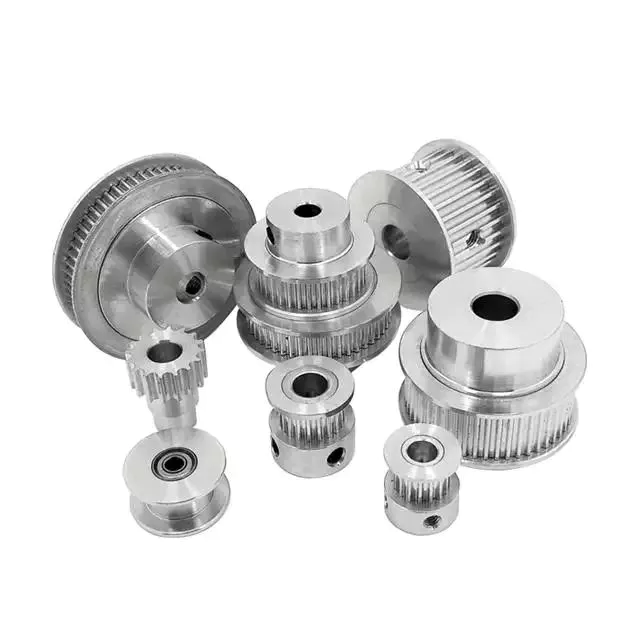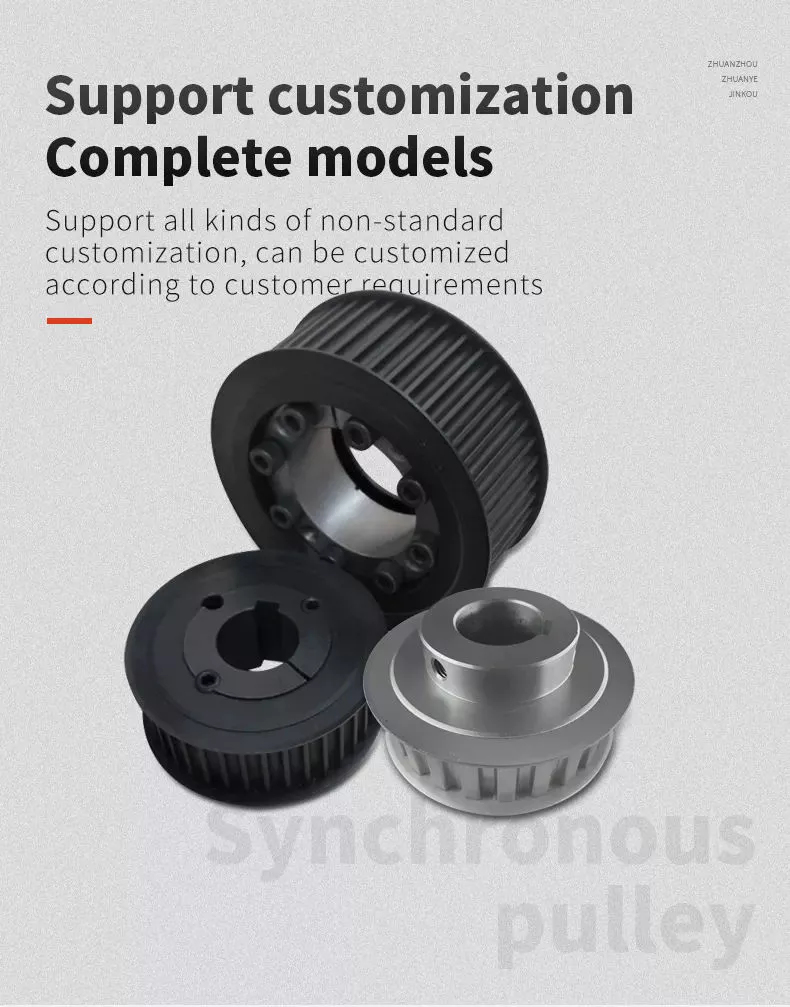Opis produktu
Opis produktu
Casting Iron Elevator Sheave Pulley for Lift Parts
Pulley Advantages:
1. Low cost &Low specific weight
2. Great rigidity ,hardness ,Corrosion resistant ,Friction-resistant and wear-resistant.
3. High impact value,Excellent sliding and emergency running properties
4. No, or very low moisture absorption
5. Dimensionally stable .Virtually no limit to the variety of dimensions and shapes
6. Low or no maintenance required
What’s more important is:
Energy efficient and environment-friendly and Can be customized ~
| Load | Speed | Outer diameter Φ | Inner diameter Φ | Wire rope diameter Φ | Grooves N |
| 450 | 0.5-1.75 | 320 | 80-110 | 8 | 3-4 |
| 550 | 1-1.75 | 320 | |||
| 630 | 1-1.75 | 320 | |||
| 800 | 1-1.75 | 320 | 100-120 | ||
| 400 | |||||
| 1000 | 1-2.5 | 320 | 110-130 | 8-10 | 5-8 |
| 400 | |||||
| 440 | |||||
| 480 | |||||
| 520 | |||||
| 1150 | 1-2.5 | 320 | 120-140 | 8-12 | 5-8 |
| 400 | |||||
| 440 | |||||
| 480 | |||||
| 520 | |||||
| 1250 | 1-2.5 | 400 | 120-140 | 8-12 | 6-8 |
| 440 | |||||
| 480 | |||||
| 500 | |||||
| 520 | |||||
| 1350 | 1-2.5 | 400 | 130-150 | 8-12 | 7-9 |
| 480 | |||||
| 520 | |||||
| 560 | |||||
| 1600 | 1-2.5 | 400 | 140-170 | 10-12 | 8-14 |
Company Infomation
Work Shop
CE Certifications
Project Cases
Często zadawane pytania
1. The Elevator Stable and Safe?
We with more than 10years production experience. Currently working with Ots,Kone and customers from more than 20countries.Our Products are Qualified with ISO9001,CE/EN81,EAC,KC.All the main parts which we use is international famous brand,make our elevator comes premium level.
2.How To Install and Maintain ?
We have been cooperated with elevator installation company more than 20countries,we never stop finding installation partner in other country everyday.To ensure our customer can enjoy both good quality and after-sales service.
3. Will The Elevator Drop Down or Clamp People Suddenly?
Our elevator get 6 lines protection ,In Machineroom,Elevator Door,Bottom of shaft. It will enter into the protection system automaticly if there is any issue .The elevator will not have such situation if the after service goes well.That’s why we have so many parters all over the world.
4. Any Cerifications ?
We are qualified with CE/EN81,EAC/CU-TR,KC,TUV Certificates.You are full protected.
Choose us.Choose ur Life Style!
| Serwis posprzedażowy: | on-Line Tech. Guidance |
|---|---|
| Gwarancja: | 1year |
| Typ: | Traction System |
| Suitable for: | Elevator, Funicular Car |
| Load Capacity: | 3000kg |
| Persons: | 11-20 |
| Próbki: |
US$ 6.8/Piece
1 sztuka (minimalne zamówienie) | |
|---|
| Personalizacja: |
Dostępny
| Spersonalizowane żądanie |
|---|

Can you explain the concept of “efficiency” in pulley systems?
W układach bloczkowych wydajność odnosi się do stosunku pracy lub mocy wyjściowej do pracy lub mocy wejściowej, biorąc pod uwagę wszelkie straty lub nieefektywności w układzie. Reprezentuje ona, jak skutecznie układ bloczkowy przekształca energię wejściową w użyteczną energię wyjściową.
Na wydajność układu bloczków mogą wpływać różne czynniki, w tym tarcie, straty mechaniczne oraz konstrukcja i stan bloczków i lin. Oto kilka kluczowych punktów, które należy zrozumieć na temat wydajności układów bloczków:
1. Mechanical Advantage and Efficiency: Pulley systems can provide a mechanical advantage by reducing the effort force required to lift a load. However, it’s important to note that while a higher mechanical advantage generally means less effort is needed, it may also result in lower efficiency. This is because as the mechanical advantage increases, the system may experience higher frictional losses and other inefficiencies.
2. Tarcie i wydajność: Tarcie odgrywa znaczącą rolę w wydajności układów kół pasowych. Interakcja między kołami pasowymi a linami lub pasami może powodować straty tarcia, które zmniejszają ogólną wydajność układu. Tarcie można zminimalizować, stosując koła pasowe z łożyskami o niskim współczynniku tarcia lub smarując powierzchnie styku.
3. Materiał liny lub pasa: Wybór materiału liny lub pasa może mieć wpływ na wydajność układu kół pasowych. Różne materiały mają różne współczynniki tarcia, elastyczności i trwałości, co może mieć wpływ na ogólną wydajność. Na przykład użycie liny lub pasa o niskim tarciu i dużej wytrzymałości może pomóc zmniejszyć straty energii i poprawić wydajność.
4. Konstrukcja i stan kół pasowych: Konstrukcja i stan kół pasowych również wpływają na wydajność. Koła pasowe powinny być prawidłowo wyrównane, mieć gładkie powierzchnie i być wolne od uszkodzeń lub zużycia. Niewłaściwie wyrównane lub zużyte koła pasowe mogą zwiększyć tarcie i zmniejszyć wydajność.
5. Obciążenie układu: Wydajność układu kół pasowych może się różnić w zależności od wielkości podnoszonego lub przenoszonego ładunku. Większe obciążenia mogą powodować zwiększone tarcie i straty mechaniczne, co prowadzi do niższej wydajności.
Wydajność jest zazwyczaj wyrażana w procentach, przy czym 100% oznacza idealnie wydajny system, w którym cała energia wejściowa jest przekształcana w użyteczną energię wyjściową. W rzeczywistych systemach kół pasowych wydajność jest często mniejsza niż 100% z powodu różnych czynników, w tym tarcia, generowania ciepła i innych strat.
It’s important to consider efficiency when designing or evaluating pulley systems. Higher efficiency means a more effective use of input energy, reduced energy waste, and improved overall performance.

What role do pulleys play in modern elevators and hoists?
Pulleys play a crucial role in modern elevators and hoists, enabling the smooth and efficient vertical movement of loads. They are integral components of the lifting mechanisms, providing mechanical advantage and facilitating safe and controlled operation. Here’s how pulleys are used in modern elevators and hoists:
1. Lifting Mechanism: In elevators and hoists, pulleys are part of the lifting mechanism that moves the load vertically. They are typically combined with cables, ropes, or belts to create a pulley system. By distributing the load’s weight across multiple lines and changing the direction of the applied force, pulleys make it easier to lift heavy loads. The number and arrangement of pulleys can vary depending on the specific design and requirements of the elevator or hoist.
2. Counterweight Systems: Modern elevators often utilize counterweight systems to offset the weight of the elevator car and reduce the amount of power required for operation. Pulleys play a crucial role in these systems by guiding the cables connected to the counterweight. As the elevator car moves up or down, the counterweight moves in the opposite direction, balancing the load. The pulleys in the counterweight system help distribute the weight and ensure smooth movement.
3. Traction Control: Pulleys are also involved in the traction control mechanism of elevators and hoists. Traction elevators use ropes or belts that pass over a series of pulleys, known as sheaves, to create traction. An electric motor drives the sheaves, causing the ropes or belts to move. By adjusting the rotational movement of the sheaves, the speed and direction of the elevator or hoist can be controlled. The pulleys in the traction control system enable precise and reliable operation.
4. Safety Systems: Pulleys play a crucial role in the safety systems of elevators and hoists. For example, in traction elevator systems, overspeed governors utilize pulleys to detect excessive speed and activate the safety brakes in case of a malfunction. The pulleys in these safety systems help monitor and control the elevator’s speed, ensuring passenger safety.
5. Maintenance and Service: Pulleys in modern elevators and hoists are designed to be durable and require minimal maintenance. They are often equipped with sealed bearings or other lubrication systems to reduce friction and wear. This ensures the longevity and reliability of the pulley systems, minimizing downtime and maintenance costs.
Overall, pulleys are essential components in modern elevators and hoists, enabling vertical movement, providing mechanical advantage, ensuring safety, and facilitating efficient operation. They contribute to the smooth and controlled lifting of loads, making elevators and hoists reliable and indispensable tools in various industries and buildings.

In which industries are pulleys extensively used?
Pulleys are extensively used in various industries for a wide range of applications. Here are some of the industries where pulleys find extensive use:
1. Manufacturing and Industrial: Pulleys are widely used in manufacturing and industrial settings. They are employed in conveyor systems for material handling, assembly lines, and production processes. Pulleys are also utilized in machinery and equipment such as pumps, compressors, generators, and conveyors. These industries rely on pulley systems for efficient movement of materials, power transmission, and mechanical advantage.
2. Construction and Engineering: The construction and engineering industries heavily rely on pulleys for lifting and moving heavy loads. Cranes, hoists, and winches utilize pulley systems to provide mechanical advantage and precise control over lifting operations. Pulleys are also employed in scaffolding systems, elevators, and material handling equipment used in construction projects.
3. Mining and Quarrying: In mining and quarrying operations, pulleys are used in various applications. They are utilized in conveyor systems to transport bulk materials such as coal, ore, and aggregates. Pulleys play a crucial role in mining equipment such as crushers, screens, and excavators, enabling efficient material handling and processing.
4. Transportation and Logistics: The transportation and logistics industries utilize pulleys in various ways. Pulleys are integral components in vehicles, including cars, trucks, buses, and trains. They are used in engines, power steering systems, alternators, and air conditioning systems. In logistics, pulleys are employed in conveyor belts and sorting systems for efficient movement of packages and goods in warehouses and distribution centers.
5. Agriculture and Farming: Pulleys have significant applications in the agriculture and farming sectors. They are used in machinery such as tractors, combines, and harvesters for power transmission and drive systems. Pulleys are also utilized in irrigation systems, grain elevators, and feed processing equipment.
6. Marine and Offshore: Pulleys find extensive use in marine and offshore industries. They are employed in shipbuilding, offshore drilling rigs, and maritime equipment. Pulleys are used in winches, cranes, anchor systems, and rigging applications. They enable safe and efficient lifting, lowering, and positioning of heavy equipment and cargo on ships and offshore platforms.
7. Energy and Utilities: The energy and utilities sectors utilize pulleys in power generation and transmission systems. Pulleys are used in turbines, generators, and power plants to transfer rotational motion and transmit power. They are also employed in renewable energy systems such as wind turbines and hydroelectric plants.
8. Entertainment and Stage Production: Pulleys have applications in the entertainment and stage production industries. They are used in theater rigging systems, concert stages, and amusement park rides. Pulleys enable the controlled movement of scenery, lighting equipment, and performers, ensuring smooth and precise operations.
These are just a few examples of the industries where pulleys are extensively used. Pulleys play a crucial role in a wide range of applications, providing mechanical advantage, power transmission, and efficient movement of loads in numerous industrial sectors.


redaktor przez CX
2023-12-08
